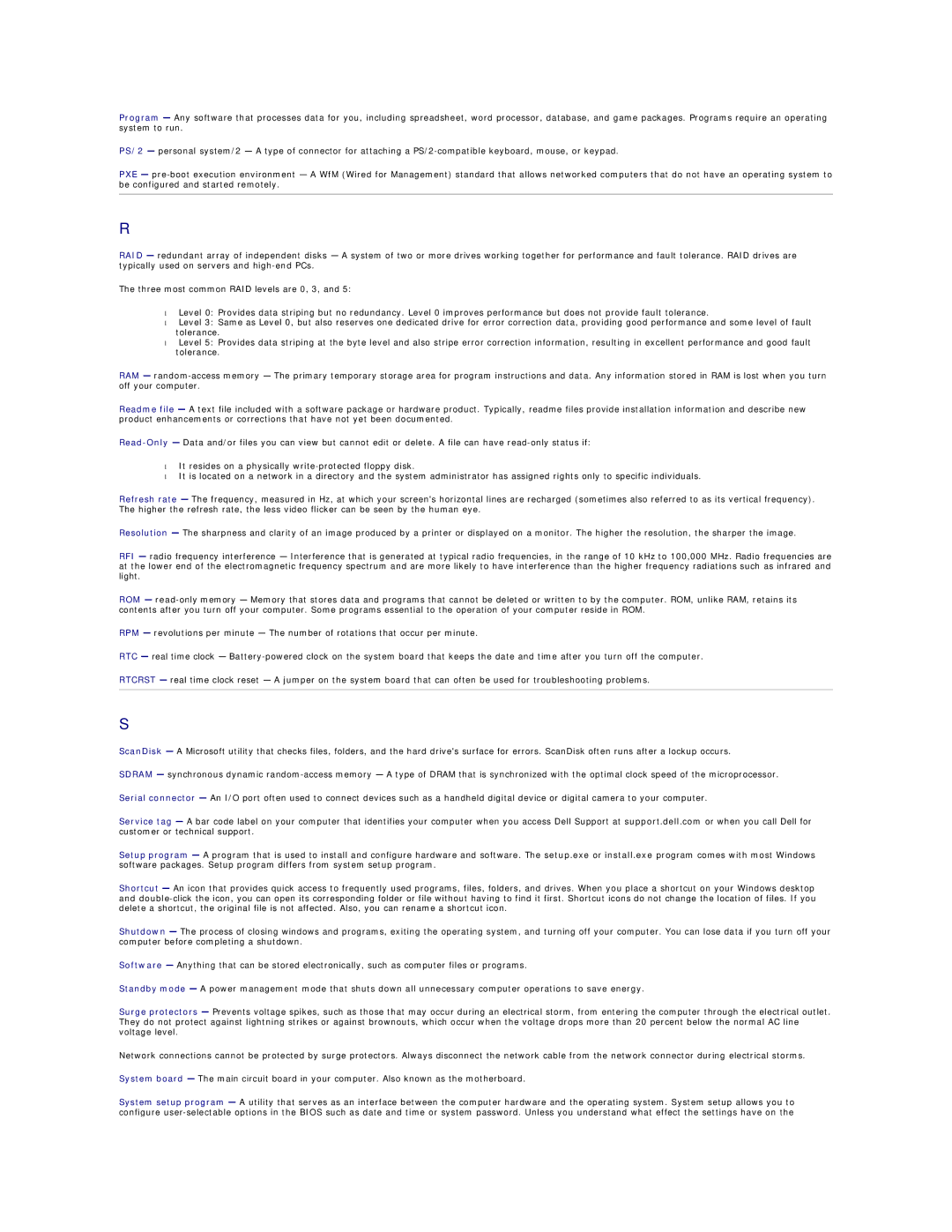
Program — Any software that processes data for you, including spreadsheet, word processor, database, and game packages. Programs require an operating system to run.
PS/2 — personal system/2 — A type of connector for attaching a
PXE —
R
RAID — redundant array of independent disks — A system of two or more drives working together for performance and fault tolerance. RAID drives are typically used on servers and
The three most common RAID levels are 0, 3, and 5:
•Level 0: Provides data striping but no redundancy. Level 0 improves performance but does not provide fault tolerance.
•Level 3: Same as Level 0, but also reserves one dedicated drive for error correction data, providing good performance and some level of fault tolerance.
•Level 5: Provides data striping at the byte level and also stripe error correction information, resulting in excellent performance and good fault tolerance.
RAM —
Readme file — A text file included with a software package or hardware product. Typically, readme files provide installation information and describe new product enhancements or corrections that have not yet been documented.
•It resides on a physically
•It is located on a network in a directory and the system administrator has assigned rights only to specific individuals.
Refresh rate — The frequency, measured in Hz, at which your screen's horizontal lines are recharged (sometimes also referred to as its vertical frequency). The higher the refresh rate, the less video flicker can be seen by the human eye.
Resolution — The sharpness and clarity of an image produced by a printer or displayed on a monitor. The higher the resolution, the sharper the image.
RFI — radio frequency interference — Interference that is generated at typical radio frequencies, in the range of 10 kHz to 100,000 MHz. Radio frequencies are at the lower end of the electromagnetic frequency spectrum and are more likely to have interference than the higher frequency radiations such as infrared and light.
ROM —
RPM — revolutions per minute — The number of rotations that occur per minute.
RTC — real time clock —
RTCRST — real time clock reset — A jumper on the system board that can often be used for troubleshooting problems.
S
ScanDisk — A Microsoft utility that checks files, folders, and the hard drive's surface for errors. ScanDisk often runs after a lockup occurs.
SDRAM — synchronous dynamic
Serial connector — An I/O port often used to connect devices such as a handheld digital device or digital camera to your computer.
Service tag — A bar code label on your computer that identifies your computer when you access Dell Support at support.dell.com or when you call Dell for customer or technical support.
Setup program — A program that is used to install and configure hardware and software. The setup.exe or install.exe program comes with most Windows software packages. Setup program differs from system setup program.
Shortcut — An icon that provides quick access to frequently used programs, files, folders, and drives. When you place a shortcut on your Windows desktop and
Shutdown — The process of closing windows and programs, exiting the operating system, and turning off your computer. You can lose data if you turn off your computer before completing a shutdown.
Software — Anything that can be stored electronically, such as computer files or programs.
Standby mode — A power management mode that shuts down all unnecessary computer operations to save energy.
Surge protectors — Prevents voltage spikes, such as those that may occur during an electrical storm, from entering the computer through the electrical outlet. They do not protect against lightning strikes or against brownouts, which occur when the voltage drops more than 20 percent below the normal AC line voltage level.
Network connections cannot be protected by surge protectors. Always disconnect the network cable from the network connector during electrical storms.
System board — The main circuit board in your computer. Also known as the motherboard.
System setup program — A utility that serves as an interface between the computer hardware and the operating system. System setup allows you to configure
